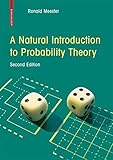A Natural Introduction to Probability Theory [electronic resource] / by Ronald Meester.
Material type: TextPublisher: Basel : Birkhäuser Basel, 2008Edition: Second EditionDescription: X, 198 p. online resourceContent type:
TextPublisher: Basel : Birkhäuser Basel, 2008Edition: Second EditionDescription: X, 198 p. online resourceContent type: - text
- computer
- online resource
- 9783764387242
- 519.2 23
- QA273.A1-274.9
- QA274-274.9
Experiments -- Random Variables and Random Vectors -- Random Walk -- Limit Theorems -- Intermezzo -- Continuous Random Variables and Vectors -- Infinitely Many Repetitions -- The Poisson Process -- Limit Theorems -- Extending the Probabilities.
According to Leo Breiman (1968), probability theory has a right and a left hand. The right hand refers to rigorous mathematics, and the left hand refers to ‘pro- bilistic thinking’. The combination of these two aspects makes probability theory one of the most exciting ?elds in mathematics. One can study probability as a purely mathematical enterprise, but even when you do that, all the concepts that arisedo haveameaningontheintuitivelevel.Forinstance,wehaveto de?newhat we mean exactly by independent events as a mathematical concept, but clearly, we all know that when we ?ip a coin twice, the event that the ?rst gives heads is independent of the event that the second gives tails. Why have I written this book? I have been teaching probability for more than ?fteen years now, and decided to do something with this experience. There are already many introductory texts about probability, and there had better be a good reason to write a new one. I will try to explain my reasons now.
There are no comments on this title.



























